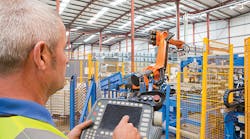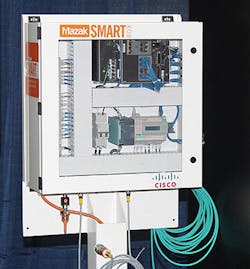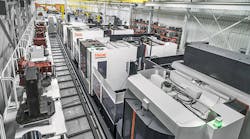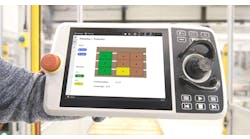For all the enthusiastic predictions from high-tech analysts, manufacturers seem to be only tentatively embracing the Industrial Internet of Things — the concept of a universal operating platform: according to Cisco, the developer of network programming and devices, 92% of 64 million manufacturing machines in operation worldwide are not connected to any network.
The IoT, you may recall, is the virtual network established by tying together individual sensors, connective devices, analytics programs, and process controls, and unifying systems worldwide to optimize information flow and responsiveness. And, manufacturing is only one facet of this proposition, others being the energy sector, transportation, and civilian/governmental information networks (shorthand, “smart cities.”)
While most manufacturers are familiar by now with “cloud computing” (i.e., remote, secure data storage), this arrangement is more commonly described as “fog computing”, or fog networking, because it uses one or a collaborative multitude of end-user clients for computing and data storage (in contrast to using cloud data centers.) The fog cluster is also responsible for communication, control, data configuration, and more essential functions of a data network.
While all this promises to make data collection and analysis faster and more dynamic, and thereby improve process control, it’s still a vast and challenging proposition for manufacturers. It requires more than the usual level of trust between supplier and customer. But, it’s a vision that’s hard to contain, and Cisco is rolling out a bundle of new devices and capabilities it intends to use to make the possibilities more realistic to individual manufacturers.
Cisco Connected Machines is a control platform the developer promises will connect control devices securely, create fog networking feasible and effect, and convert machine data into real-time analysis. Connected Machines functions as a link between machine designers/builders and the manufacturers using them, which is foreseen as a way to promote process improvements via “real-time corrective action and continuous, predictive maintenance.”
Two products being introduced this month will expand the scope of the Connected Machines platform, including a new series of switches (IE4000) operating on the IOx operating system. This means the platform is able to deliver pluggable micro-services and can integrate with IoT sensors and cloud applications while processing data nearer to the machine. Cisco also introduced “Connected Streaming Analytics,” real-time analysis of process activity via the IE4000, for small footprint deployment.
Cisco has made significant progress in the machine-tool space thanks to its co-development efforts with Mazak Corp. Cisco Connected Machines is the operating system for Mazak’s SmartBox technology, which connects manufacturing equipment to a factory network. SmartBox uses the Cisco IE4000 with MTConnect (a “fog network”) and connected streaming analytics.
Connecting Machines, Connecting Plants
“Mazak continues to drive toward its iSMART Factory concept that uses advanced manufacturing cells and systems together with full digital integration to achieve free-flow data sharing in terms of process control and operation monitoring,” stated president Brian Papke. “Within that concept, the connection of today’s manufacturers to the Industrial Internet of Things allow them to achieve levels of efficiency and productivity never before realized.
“And, while the Mazak iSMART Factory concept centers around open connectivity and the Internet, we must also provide those manufacturers the highest level of security possible,” Papke added, noting that Mazak’s collaboration with Cisco is achieving that security.
Cisco also is expanding its Connected Factory platform, which allows industrial organizations to integrate industrial automation and control with business systems, build a common “plant-to business” network, and locate and resolve problems to improve uptime and equipment availability. It is introducing a new multi-gigabit speed ruggedized switch (IE 4010) that offers in-line Power over Ethernet/PoE+ multi-speed Ethernet ports, that can power up to 24 other devices in industrial applications. Another new switch, IE 1000, is a rugged but more compact option, with in-line PoE/PoE+ multi-speed Ethernet ports for up to eight other industrial devices.
Because an increasing number of IoT devices are connecting to the Internet (Cisco predicts the number will reach 50 billion by 2020); and because approximately 45% of such IoT devices are constrained by battery power and require long range for IoT connectivity, Cisco is offering a new platform low-power-wide-area network (LoRaWAN) enabled with WiFi and cellular technologies, to connect with “billions of such battery powered, low-data rate and long distance IoT sensors.”
Cisco is not the only developer trying to help manufacturers find their way in the fog. Honeywell Process Solutions is offering fully integrated system of process software to convert plant data into actionable information. According to Ali Raza, v.p. of HPS’ Advanced Solutions business, the Uniformance® Suite lets users “capture the data they need, visualize trends, collaborate with other users, predict and prevent equipment failures, and act to make informed business decisions.”
Using a common asset model, Uniformance collects and stores all types of data for easy retrieval and analysis; predicts and detects events based on underlying patterns and correlations; links process metrics with business KPIs, to inform decision-making. Besides the IoT access, it allows user mobility and cloud connectivity, big data access, and predictive and enterprise analytics.
HPS also offers a new programmable logic controller it contends will manage dual requirements of connectivity and device integration necessary for plants to realize IoT in their own operation. The ControlEdge PLC, combined with Honeywell’s Experion® Process Knowledge System (an enterprise-wide control system), will work with devices from multiple vendors, simplifying configuration and reducing maintenance.
"Plants seek to maximize their return on assets by making sure that their automation investments are scalable, future-proof, adhere to open standards, and can seamlessly integrate to existing assets, avoiding having to ‘rip and replace’ current infrastructure,” commented Craig Resnick, vice president, ARC Advisory Group, articulating one of the most apparent, but consistent inhibitors keeping manufacturers from achieving IoT connectivity. “Future-proofing” everything from the controller to the enterprise platform so that it integrates with existing assets, is the Honeywell strategy to accelerate manufacturers’ IoT availability.
Still, manufacturers understand the current state of development well enough to realize that IoT signifies a conversion of their current production processes, transferring competitive advantage from machinery to “information.” It will take the proof of performance from these devices to make manufacturers IoT-ready.











